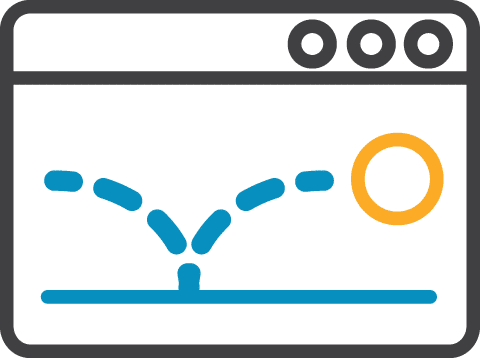10 Popular Marketing Terms You’ve Probably Heard and What They Mean
Are you new to the world of marketing? Then you’ve probably been busy surfing the internet for the best strategies and tips for your practice. In your search, you’ve likely seen a lot of terms and acronyms thrown around, but what do they mean?
ROI, SEO, PPC, oh my! There are countless terms and strategies to discover out there.
It can be a bit more difficult to follow along with educational blogs and videos when you don’t have a background in digital marketing. That’s why we’ve created a list of the 10 most popular marketing terms you’ve likely heard at least once or will hear while researching the best options for your practice.
10 Popular Marketing Terms You’ve Probably Heard and What They Mean
1. SEO
Let’s start at the top, shall we?
SEO stands for search engine optimization, a variety of strategies that are used to boost a webpage’s search engine ranking and attract clicks to their site. This is one of the most common strategies employed in marketing thanks to its long-term success.
A high ranking on Google’s search engine results pages for related keywords gives your webpages increased visibility, allowing you to reach more potential clients. About 67% of web users fail to scroll past the first page of search engine results, leaving sites sequestered to the second page unseen.
There are many strategies that fall under the umbrella of SEO, such as keyword research, bounce rates, and content marketing. But, we will get into those later.
2. Keywords
Keywords and phrases are used in web content to signal to search engine’s algorithm that your content is relevant for a particular search term. So, when you Google “best exercises for back pain”, you will get results with a variation of these keywords in the content.
Keyword research falls under the blanket of SEO. This popular strategy requires marketers to conduct research to learn which keywords and phrases perform best for their topics, industry, and location.
If you want to learn about marketing basics, keywords are a great place to start.
3. Pay-Per-Click Advertising
Pay-per-click advertising, commonly known as PPC, is aptly named. This form of digital advertising requires the business to pay a fee to a host each time their advertisement is clicked on.

Take a moment to do a search on Google. Type in something like “optometrist in Tulsa” or “chiropractor near me”. At the top of your search engine results page, do you see webpages with a green box labeled “Ad” to the left of the URL? These are pay-per-click advertisements hosted by Google Ads.
Paid advertisements are celebrated for their quick return-on-investment, with many companies making about two dollars for every dollar spent. Google Ads are particularly popular with web users, with 41% of clicks going to the top three ads.
4. Organic Search
Organic search results are paid advertisements counterpart. While you have to pay for clicks on PPC ads, you earn clicks on your web pages through organic search.
Marketers employ a variety of SEO tactics to secure their place at the top of search engine results pages, or SERPs, organically. This may include strategies such as keyword research, on-site SEO, and link building.
The goal is to rank as high as possible on relevant SERPs so that the web page attracts the maximum amount of traffic from your ideal audience. Now, the key phrase here is “ideal audience”. A great ranking on Google won’t amount to much if the right people aren’t seeing it!
Learn more about how to implement SEO on your website here.
5. Content Marketing
Content marketing relies on online materials, such as articles, videos, and social posts, to generate interest in a brand, product, or service.

This type of marketing works for several reasons. First, producing regular content allows you to establish yourself as an authority to both web users and Google’s search engine algorithm. The more quality, optimized content you publish, the better chance you have that potential clients will find your content.
Second, content enables your practice to provide value to your current and potential clients. Whether this is through educational blogs or entertaining videos, you will be able to better connect with your audience and build relationships.
Third, regularly scheduled content gives you more opportunities to implement SEO into your practice’s web presence.
6. Mobile-Optimization
Mobile-optimization ensures that your site is easily accessible by mobile devices like smartphones and tablets. It is essential that your website is mobile-responsive, especially considering 52.2% of all online traffic stems from a mobile phone.
A mobile-friendly website can also help you rank higher on Google’s search engine results pages. Google practices mobile-first indexing, meaning that a mobile-responsive site will be prioritized over traditional desktop interfaces when the site is accessed via a mobile device.
Plus, your clients like it, too. 72% of people prefer mobile-responsive sites for speed and ease of use.
7. Bounce Rate
Your bounce rate is the percentage of people that click on one of your webpages but then quickly leave the site.

A high bounce rate can be indicative of a problem with your site, be it design, page speed, or content. Acquiring a less-than-ideal bounce rate also tells Google that users aren’t finding your site useful, which then decreases your site’s search engine ranking.
8. Engagement
Nope, we’re not talking about weddings here. Engagement refers to the amount of interaction your practice’s content has online. Think: likes on social posts, comments on articles, video shares, and click-throughs to your site.
Many platforms, such as Facebook and Google, allow you to track your engagement rates using analytics. This will give you insight into what kind of content is working and what your audience likes to see online.
9. Call-to-Action
A call-to-action, better known as CTA, is a powerful piece of content that incites your audience into a desired action. An example of a common type of CTA would be a statement on one of your landing pages that instructs viewers to make an appointment at your practice.
When writing a call-to-action, be clear and direct. Your future client should be able to look at your web page or content and easily discern what action they need to take to secure your product, services, or information.
10. User Experience

User experience is often referred to simply as UX. What can we say, the marketing industry loves abbreviations. Efficiency is key!
UX describes a person’s overall experience with a website or product. The quality of UX is typically determined by criteria like usability, ease-of-access, site design, user interface.
That may sound a little complicated, but you probably understand many of these concepts by being an internet user yourself! Check out this blog for more details on how to create a great user experience on your site.
Now that you’re versed on marketing basics…
It’s time to implement some of these tactics at your practice! We suggest starting slow. Dip your toes in with a little keyword research, then move on to more advanced strategies like technical SEO.
Need a little help to get started? Contact our team and a knowledgeable Internet Consultant will help you draft a plan to reach your business goals.
For more educational resources, check out these articles.
Top SEO Trends of 2019
Should You Use SEO or Google Ads?
Reach the Clients You Want With Pay-Per-Click Advertising



